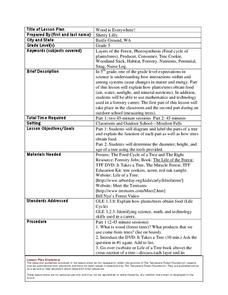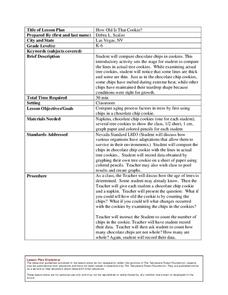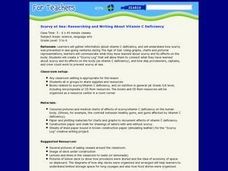Curated OER
Hereditary Defects: Down Syndrome and Sickle Cell Anemia
Students solve problems like the following examples: 1. If you have 10,000 women, age 30, who have babies and one in 900 of these births will result in a Down syndrome baby, how many will have this disease? 2. 5,000 babies are born;...
Curated OER
Linoleum Block Printing
Students create linoleum block prints using linoleum squares, knives, ink, and paper in this Art lesson plan for 4th through 12th grades. It is suggested to introduce the concept of printmaking prior to this lesson plan (resource links...
Curated OER
How Deep is the Ocean
Students predict and then analyze the layout of the tectonic plates that form the ocean's floor using mapping skills and Inquiry based problem solving, They compare the depth of various regions in the ocean with the geologic age to...
Curated OER
Logic Puzzles
In this logic puzzle instructional activity, learners read 2 clues pertaining to a logic puzzle. They then solve the puzzle by filling in the grid provided. Students can click on the Check box to determine whether their answer is correct...
Curated OER
Puberty
Students identify three physical and emotional changes boys and girls go through at puberty. They also discuss the difference in ages in which puberty occurs and complete worksheets.
Curated OER
Defining the American Dream
Pupils define the American Dream and apply their knowledge of American history to evaluate the main idea of H.W. Brands' book, "The Age of Gold."
Curated OER
Reel Remembrances
Students interview adults, ages 71-75. They ask them questions concerning events of 60 years ago and create a media presentation based upon background information and interview responses.
Curated OER
People Everywhere
Second graders identify people of different ages, cultural backgrounds, traditions, and careers and explain how they contribute to the community. Then they create a collage of different people of a community with 100% accuracy. ...
Curated OER
Historical Witness: Social Messaging
Research European expansionism and colonialism during the Age of Exploration. Study the Marquise de Miramon and discuss the objects from Japan. Research Europe's expansionism and colonialism during the Age of Exploration by working in...
Curated OER
Wood is Everywhere!
Fifth graders diagram and label the parts of a tree. For this lesson on how trees obtain food, 5th graders diagram and label the parts of a tree, and determine the diameter, height, and age of a tree.
Curated OER
Blue Zones: Out with the old and in with the new
Seventh graders read articles about the Blue Zones, life expectancy and healthy and unhealthy habits of people around the world. In this Current Events lesson, 7th graders participate in class discussion of key terms and concepts...
Curated OER
Taking a Stand with Rosa Parks
Students discuss African-American history from slavery to the civil rights movement. They discuss individual people who shpaed history by reading their biographies and researching the age in which they lived. Studnets comprehend the...
Curated OER
Flying Through the Solar System
Students create a model of the solar system out of candy. They write a book about their travels through the Solar System, beginning at age ten and reaching Pluto at age seventy.
Curated OER
Giving Game--Planning to Make The World
Middle schoolers, in groups, examine plans to make the world a beter place. They evaluate the plans based on feasibility, practicality, and do-ability by students their own age.
Curated OER
Data-gathering Activities Relating to Trees in Their Environment
Students gather data relating to trees in their environment. In this biology lesson plan, students determine heights of trees and their ages. A canopy map will indicate optimal growing areas for the tree.
Curated OER
How Old is that Cookie?
Students investigate adaptation. In this cookie age activity, students examine changes and variations in chocolate chips in cookies in preparation for determining the age of trees using lines. Students discuss how the age of trees is...
Curated OER
How does Your Province Stack Up?
Students investigate data about age, and sex of a population. In this statistics lesson, students are given data on a population to analyze and compare to other provinces. This assignment is part of a geography lesson and requires 3...
Curated OER
Scurvy at Sea: Researching and Writing About Vitamin C Deficiency
Students gather information about vitamin C deficiency, and research how scurvy was prevented in sea-going ventures during The Age of Sail. They create a "Scurvy Log" that will allow them to connect what they have learned about scurvy...
Curated OER
Paper Maracas
Students create paper maracas using basic art supplies, paper plates, beans, and decorative materials in this Art and Music lesson for the 1st and 2nd grades. The lesson includes resource links, a vocabulary list, and a short historical...
Curated OER
Some Ways to Integrate Trade, the "Missing Link" into Ancient History
Ninth graders examine the importance of trade in the Mediterranean Sea. In groups, they create a chart of the items that were most popular in the late Bronze Age and where they originated. To end the lesson, they read an article out of...
Curated OER
Back-to-School Meet & Greet
Student are welcomed into a new learning environment through reading and age-appropriate activities that help relieve the anxiety of beginning school in a new place and with new friends. For this Clifford-themed lesson plan, students...
Curated OER
Courage
Students review the definition and the need for courage. As a class, they brainstorm a list of ways one can be couragous at different ages. In groups, they apply courage to the four facets of life and share their responses with the...
Curated OER
Social Studies: Medieval and Contemporary Class Structures
Students discuss and compare contemporary class systems with those of the Middle Ages. They explore Websites on HyperStudio stack and review art and music of the Middle Ages. In groups, students design and draw castles reflecting manor...
Curated OER
Radio Show
Learners work in groups to write a radio drama based on an event or period in history. They write commericals that are appropriate for the radio age and create sound effects. The radio shows are recorded using an iPod and a voice...

























